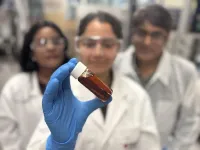(Press-News.org) Education projects supporting marginalised girls in lower-income countries are more likely to achieve lasting transformations when they mobilise young women and their communities as “agents of change”, a new report indicates.
The recommendation comes from the latest evaluation of the Girls’ Education Challenge: a UK Government-supported initiative which has funded projects reaching more than 1.6 million girls. The University of Cambridge-led study finds that these projects initiated “virtuous cycles” of change – particularly by rooting themselves in communities and empowering young women to lead the way.
In many low- and lower-middle-income countries, girls face persistent inequalities that limit their learning and life chances. Many drop out of school early due to early marriage, pregnancy or because they are expected to work at home. Marginalised girls, who live in extreme poverty, have disabilities, or come from remote areas, are least likely to attend or complete school.
Although some aid programmes target marginalised girls, their impact can be short-lived. Aside from the difficulties of changing deep-seated social norms, the initial momentum from girls’ education programmes is easily lost when funding ends, and is also vulnerable to economic shocks, conflict, and environmental crises. For this reason, the new evaluation explores how far Girls’ Education Challenge (GEC) projects managed to deliver sustainable change, and under what conditions.
The study was undertaken by a collaboration which has carried out previous evaluations for the GEC, led by the Research for Equitable Access and Learning (REAL) Centre at the Faculty of Education, University of Cambridge. One earlier study, in 2023, provided substantive evidence of the projects’ success in enhancing the learning and life opportunities of marginalised girls, but warned that long-term success would depend on sustained investment.
Although it reiterates that warning, the new report, which is based on evidence from 27 projects with a particular focus on Nepal and Zimbabwe, expresses cautious optimism that they have laid the foundations for lasting progress.
REAL Centre Director, Professor Pauline Rose, said: “Many girls’ education projects emphasise the importance of community buy-in, but the GEC projects succeeded in part because they also worked through communities – embedding processes of transformation in local structures and making communities, along with young women themselves, the carriers of change.”
One key reason for the projects’ success, the authors argue, was their relatively long duration, from 2017 to 2024. This allowed them to challenge entrenched social norms – such as support for preventing early marriage or gender-based violence – that often represent barriers to girls’ education and life chances.
Rather than simply running awareness campaigns, many projects engaged influential local figures, groups and school committees to help challenge these attitudes. In Zimbabwe, for instance, a mothers’ support group and local faith leaders were engaged to monitor girls’ wellbeing, and proved instrumental in identifying and reporting cases of child abuse and early marriage. One teacher-mentor told the researchers that their efforts had “significantly reduced incidents of early marriage”.
In Nepal, parent-teacher associations and school management committees were directly involved in managing school supplies, handling requests for uniforms and hygiene items for girls attending school, and delivering GEC activities. Local businesses provided work experience and supported the girls’ career development. This embedded approach, which mobilises the community to support girls’ education is, the report suggests, key to sustainability.
Echoing findings from the 2023 report, the authors also emphasise the importance of empowering young women as “agents of change”. In several of the participating countries, graduates of GEC-backed projects were trained to run life skills sessions, support groups, and mentoring schemes for other students. This approach, which is embodied in initiatives such as the Campaign for Female Education’s “Learner Guides” programme, is increasingly acknowledged as invaluable to sustaining progress in girls’ education and has also been adopted by organisations such as UNICEF and the World Bank.
Beyond its immediate educational impact, the new study suggests that this model had ripple effects which reshaped social expectations. As girls progressed into higher education or employment, the report suggests they became visible role models who helped communities perceive the broader benefits of ensuring access to a quality education. “Once people have moved forward and grabbed education, they can’t think of going backward and not educating their children,” one teacher in Nepal told the research team.
A third mechanism of long-term change was the projects’ alignment with national and local government priorities, as well as the work of other organisations. In Nepal, authorities took direct responsibility for aspects of the GEC project, for example; while an implementing partner in Uganda emphasised the importance of the project’s integration into school development planning and governance.
Although it suggests that the GEC projects have therefore laid the groundwork for sustained progress, the report also draws attention to the basic fragility of girls’ education, especially its vulnerability to system-wide shocks and emergencies. One GEC partner in Kenya, for instance, reported that after a prolonged drought, some families had begun to see the “bride price” they might get for marrying off their daughters as a potential solution to their financial difficulties. “That may erode the gains we have worked towards,” they said.
“Unfortunately, girls’ education, particularly for the most marginalised, is often a casualty of any crisis,” Dr Amna Ansari, the report’s lead author, said. “We need the international community and national governments alike to remain committed to supporting it, but the mechanisms for sustaining positive change are nevertheless becoming clear. When communities are mobilised, girls are empowered to lead, and projects are connected to their systemic context, a virtuous cycle emerges, along with a groundswell of local support. Those are the features that can carry change forward.”
The report can be accessed here.
ENDS.
END
Girls’ education projects succeed when whole communities ‘live the change’ and carry it forward
A study of 27 projects educating marginalized girls in lower- and middle-income countries finds that whole communities need to be mobilized as “agents of change” to ensure the effects last
2025-04-09
ELSE PRESS RELEASES FROM THIS DATE:
European bird declines linked to range of climatic conditions experienced
2025-04-09
New research suggests conservation efforts could more effectively identify and protect bird species at greatest risk from climate change by better understanding the range of specific conditions they need to thrive.
The study, led by the University of East Anglia (UEA), examined the relationship between the extent of the climatic conditions that species tolerate and in which populations can survive - known as climatic niche breadth - and their likelihood of declining in response to climate change.
For species inhabiting a similar area of geographic space, those able to tolerate ...
'Hidden galaxies' could be smoking gun in universe riddle
2025-04-09
Astronomers have peered back in time to find what looks like a population of 'hidden' galaxies that could hold the key to unlocking some of the universe's secrets.
If their existence is confirmed it would "effectively break current models of galaxy numbers and evolution".
The possible galaxies may also provide the missing piece of the puzzle for the energy generation in the universe in infrared light.
That's because their combined light would be enough to top-up the energy budget of the universe to the maximum we observe, effectively ...
Love songs in the sand: researchers listen in to Fiddler crab courtship
2025-04-09
UNDER EMBARGO UNTIL 00:01 BST THURSDAY 10 APRIL / 19:01 ET WEDNESDAY 9 APRIL 2025
For the first time, a study led by University of Oxford researchers has ‘listened in’ to the fascinating courtship displays of Fiddler crabs using geophones. The findings, published today in the Journal of Experimental Biology, provide new insights into how the animals communicate effectively on the noisy seashore.
For male fiddler crabs, vibrational signals are a crucial part of their courtship routines – produced by drumming the ground using their oversized claw, ...
Study suggests lean muscle mass loss can be minimized during weight loss therapy using newer incretin obesity drugs
2025-04-09
New research to be presented at this year’s European Congress on Obesity (ECO 2025, Malaga, Spain, 11-14 May) shows that patients using GLP-1 or combined GLP-1 / GIP receptor agonist therapy for weight loss experienced minimal lean muscle mass loss as they lost weight across 6 months of treatment. The study is by Dr Dinabel Peralta-Reich, Donald and Barbara Zucker School of Medicine at Hofstra/Northwell; Lenox Hill Hospital, Northwell Health, New York City, NY, USA, and Dr Alexandra Filingeri, New York Weight Wellness Medicine, New York City, NY, USA, and colleagues.
GLP-1 (glucagon-like peptide-1) receptor agonists, ...
Aussie tech helps make bio-oils for greener industrial applications
2025-04-09
Australian technology developed at RMIT University could enable more sustainable and cheaper production of bio-oils to replace petroleum-based products in electronic, construction and automotive applications.
The technology, known as PYROCOTM, uses high temperatures without oxygen to convert treated sewage (biosolids) into a carbon-rich product called biochar, which can act as a catalyst to produce phenol-rich bio-oil.
PYROCOTM has been developed by RMIT in collaboration with South East Water, Intelligent Water Networks and other water authorities over several years and is now being applied to several exciting circular economy applications.
The RMIT team's latest research in collaboration ...
Map of genetic regulation in chickens could help fight against bird flu
2025-04-09
An international team of researchers led by Professor Huaijun Zhou from the UC Davis Department of Animal Science has created the first-ever detailed map of how genes are regulated in chickens — a breakthrough that could help scientists breed birds that are more resistant to diseases like avian influenza.
The study, published April 8 in Nature Genetics, brings together a massive amount of genetic and epigenetic data of more than 100 chicken breeds from around the world. The team, which ...
Scientists map unprecedented detail of connections and visual perception in the mouse brain
2025-04-09
What: In a massive scientific effort funded by the National Institutes of Health (NIH), hundreds of researchers have helped to map the connections between hundreds of thousands of neurons in the mouse brain and then overlayed their firing patterns in response to visual stimuli. This breakthrough is a critical piece of foundational science to build toward understanding how our brains process visual information to reconstruct the images we see every day.
Information processing in the human brain occurs ...
Mapping mercury contamination in penguins of the Southern Ocean
2025-04-09
In 1962, when environmentalist and author Rachel Carson penned Silent Spring, alerting the world to the dangers of the pesticide DDT, it was the reproductive threat to birds – the bald eagle in particular – that spurred people to action.
Six decades later, Rutgers University–New Brunswick researchers are taking the measure of another global environmental pollutant by drawing parallels to the crisis Carson identified. This time, the pollutant is mercury, and the sentinels are penguins living in the farthest reaches of the Antarctic Peninsula.
“With mercury, there’s an analogy to DDT,” said John Reinfelder, a professor in the Department of Environmental Sciences ...
Engineer aims to make giant leap for welding materials on the moon
2025-04-09
Before humans can colonize the moon or Mars, scientists and engineers must first develop techniques for building permanent structures and pressurized habitats in harsh, thin-atmosphere and low-gravity environments.
Dr. Wei Li, an assistant professor of mechanical engineering in the Erik Jonsson School of Engineering and Computer Science at The University of Texas at Dallas, is developing a virtual lunar welding platform to troubleshoot assembling large structures in such conditions.
“As we try to return to the ...
Tracking firearm violence and impact on dental health
2025-04-09
Higher firearm violence in neighborhoods is linked to lower rates of people going to the dentist and higher rates of total tooth loss, known as edentulism, according to Rutgers researchers.
Their study, published in the American Journal of Preventive Medicine, used data from the Centers for Disease Control and Prevention for dental care utilization and complete loss of teeth and data from the American Violence Project for firearm violence incidents. The researchers examined 20,332 census tracts within the 100 largest cities in the United States from 2014 to ...
LAST 30 PRESS RELEASES:
Scientists boost cell "powerhouses" to burn more calories
Automatic label checking: The missing step in making reliable medical AI
Low daily alcohol intake linked to 50% heightened mouth cancer risk in India
American Meteorological Society announces Rick Spinrad as 2026 President-Elect
Biomass-based carbon capture spotlighted in newly released global climate webinar recording
Illuminating invisible nano pollutants: advanced bioimaging tracks the full journey of emerging nanoscale contaminants in living systems
How does age affect recovery from spinal cord injury?
Novel AI tool offers prognosis for patients with head and neck cancer
Fathers’ microplastic exposure tied to their children’s metabolic problems
Research validates laboratory model for studying high-grade serous ovarian cancer
SIR 2026 delivers transformative breakthroughs in minimally invasive medicine to improve patient care
Stem Cell Reports most downloaded papers of 2025 highlight the breadth and impact of stem cell research
Oxford-led study estimates NHS spends around 3% of its primary and secondary care budget on the health impacts of heat and cold in England
A researcher’s long quest leads to a smart composite breakthrough
Urban wild bees act as “microbial sensors” of city health.
New study finds where you live affects recovery after a hip fracture
Forecasting the impact of fully automated vehicle adoption on US road traffic injuries
Alcohol-related hospitalizations from 2016 to 2022
Semaglutide and hospitalizations in patients with obesity and established cardiovascular disease
Researchers ‘listen in’ to embryo-mother interactions during implantation using a culture system replicating the womb lining
How changing your diet could help save the world
How to make AI truly scalable and reliable for real-time traffic assignment?
Beyond fragmented markets: A new framework for efficient and stable ride-pooling
Can shape priors make road perception more reliable for autonomous driving?
AI tracks nearly 100 years of aging research, revealing key trends and gaps
Innovative techniques enable Italy’s first imaging of individual trapped atoms
KIER successfully develops Korea-made “calibration thermoelectric module” for measuring thermoelectric device performance
Diversifying US Midwest farming for stability and resilience
Emphasizing immigrants’ deservingness shifts attitudes
Japanese eels, climate change, and river temperature
[Press-News.org] Girls’ education projects succeed when whole communities ‘live the change’ and carry it forwardA study of 27 projects educating marginalized girls in lower- and middle-income countries finds that whole communities need to be mobilized as “agents of change” to ensure the effects last








